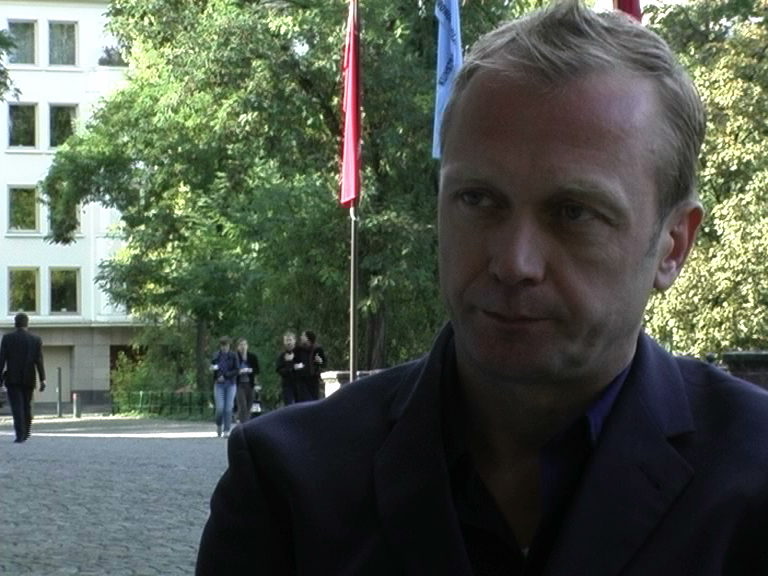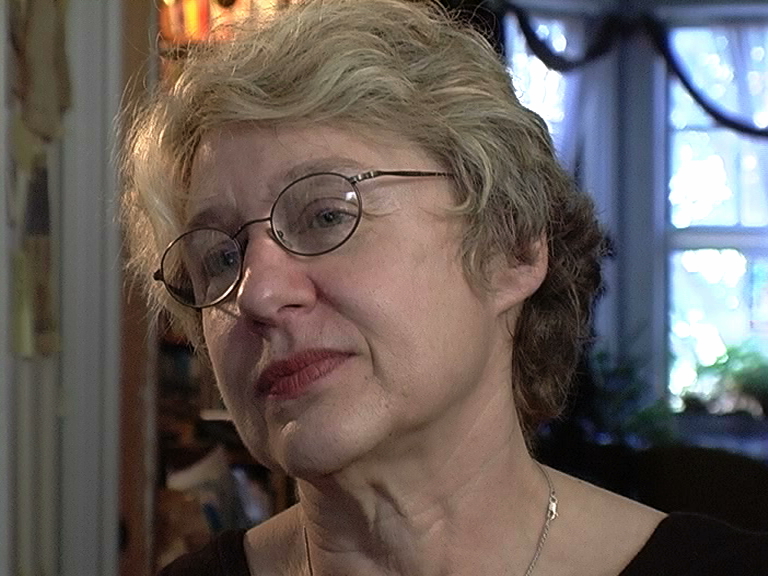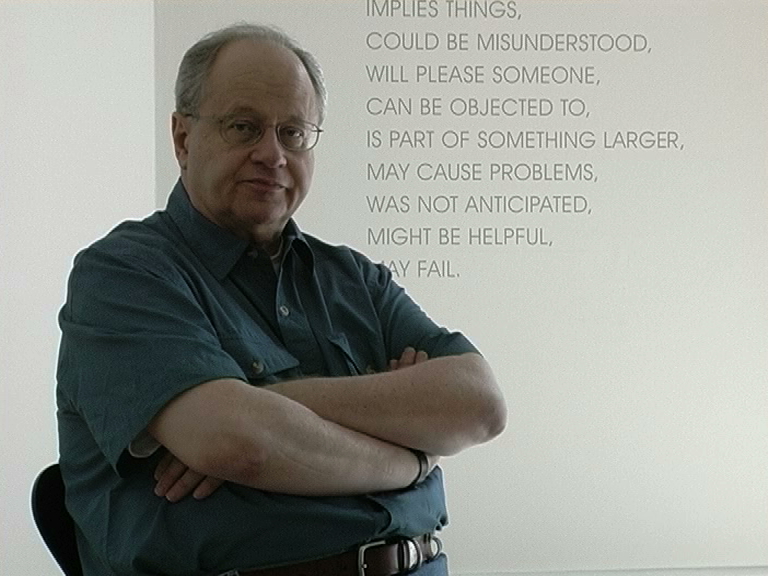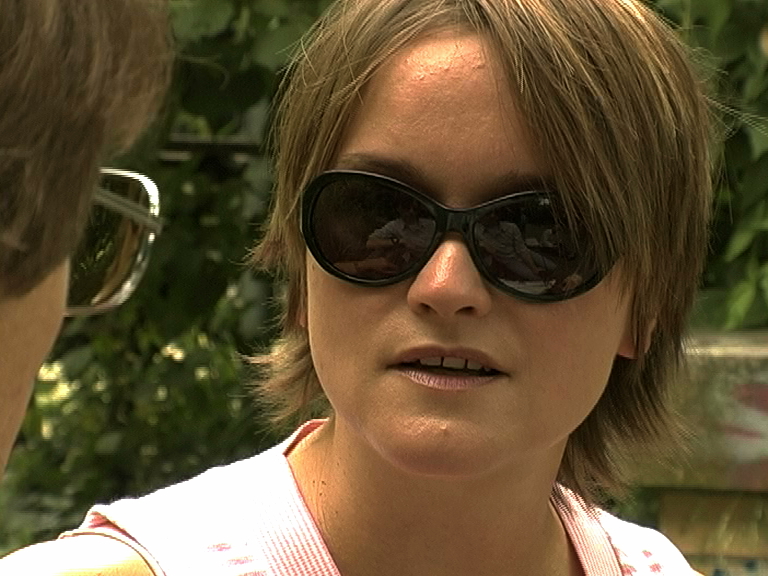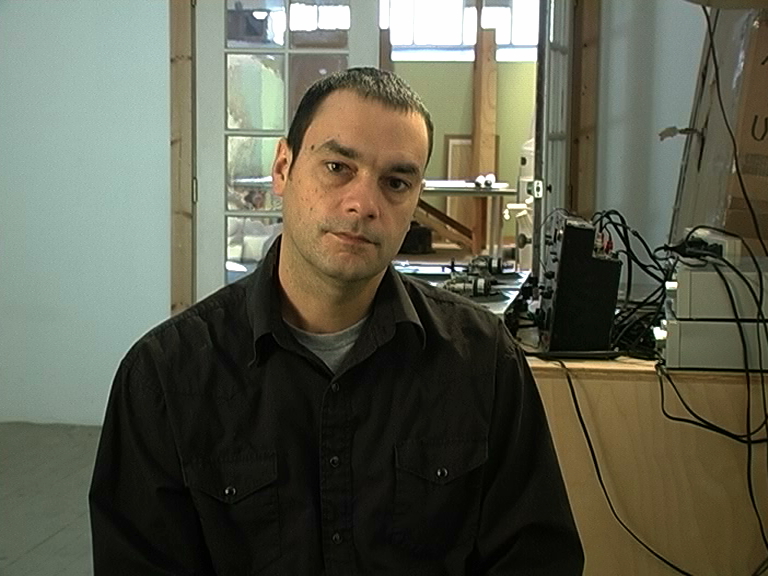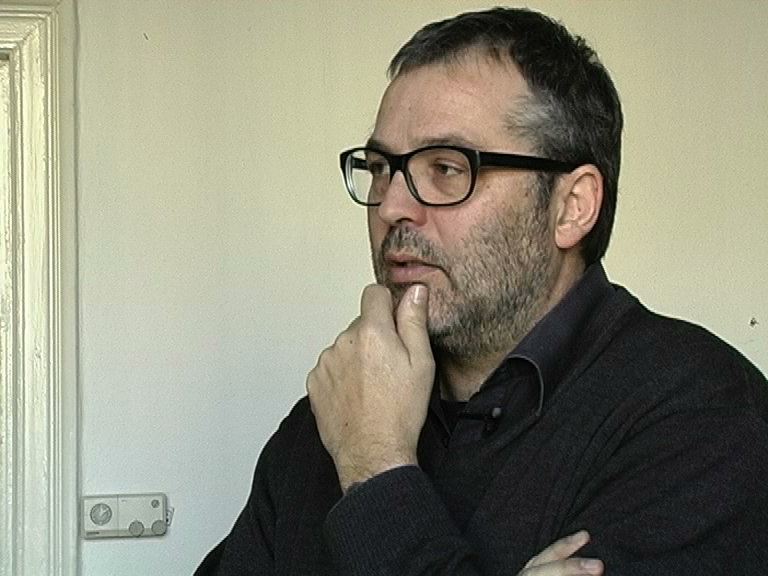S.R: So we have Ed Ruscha, in the Gagosian Gallery in New York, on the 27th of September. My first question is in relation to your talk yesterday at the Whitney Museum. At he beginning you were showing two different gear shift knobs, is that right the term? And you were talking about the difference between the Ford was is it a ’52, ’53? \\Ruscha: 1954\\ 1954 and the Caddy \\ the Chevrolet was the one and the Ford was the other\\ Chevy, sorry. And I wanted to ask you what the difference was to the Citroen 2CV?
E.R.: A considerable difference, well in those years, like in the 1950s, when I first got an automobile, it was a big thing, a big deal. There where no such things as Japanese cars, there were no such things as foreign cars, the only thing that was foreign was maybe something like what they called sports cars which were English, Austin Healey, things like that. They had barely, I don’t think there was Volkswagen when I grew up. Only in maybe the very late 50s, or certainly in the 60s when the Volkswagen Bug was a popular automobile. But there were only American cars when we grew up and so there was only an opportunity to dream about an American car. So the working man’s car was either a Ford or a Chevy or a Plymouth. Those were the three basic automobiles, and I gravitated towards a Ford. And it seemed like the gear shift knob, that little knob that you changed the gears with had more of a reality to me, the way it was shaped and the fact that you could grasp it with your entire hand and make this motion with the mechanics of the gear shift. And it became not just a functional thing, it was an industrial design choice. And I then somewhere in my mind made this a contest between the Ford and Chevy and I had a opportunity to get a Chevy. I thought I liked that Ford because of that knob. So you take these choices and they lead you somewhere else.
S.R.: And how was the Citroen?
E.R: I got the Citroen 1961 when, I liked the idea that you could buy a car for 700 $. And so I travelled with my mother an brother through Europe and we found that you could buy one of those Citroen Deux chevaux for 700 $, and new, and pick it up in Paris, drive it off and it would get incredible gas mileage. And so that was another step for me, it was like a European step for me. So I put like 60.000 miles of driving on that car.
S.R.: …It was very common in Germany to have one of those.
E.R.: Today I think they don’t allow those cars into the United States because of safety rules. // Really?// I think so, you see one, we saw often but they were probably brought here before the rules changed.
S.R.: My second question is more about a specific work in your talk yesterday. You were using some points as you were showing very American images, American constellations. If I understood it right, you said: “These are universal pictures.“ What did you mean by that?
E.R.: I wonder what I was referring to, do you remember what pictures they were?
S.R.: I think it was one with the gas stations.
E.R.: Maybe I was speaking about it in abstract terms. Because I began to the more I drove on highways in the Western US which I consider my sort of playground, you know as an artist, and I love to drive on the Western part of the United States. And gasoline stations had this what I consider a kind of a zoom. That kind of thing to the architecture and it began to influence me. And I can see this with not just an American thing. But more, like I say, universal in a sense that it’s so abstract that idea that architecture could have these different shapes and thrusts to them that I felt were not just American, the American ones they have the names on there and ones you realized what they are and the fact that they are in Arizona, New Mexico, California and Oklahoma. But the basic architecture itself goes back to something really primitive and universal.
S.R.: Okay, I understand this. There’s another question connected to your traveling through Europe. Do you think that your perspective on American culture was changed or your mind made up through yourself traveling in Europe? [break] Do you think that your perspective on your own culture, American culture and all the images labels and so on was influenced by your traveling through Europe?
E.R.: I think any kind of traveling is an educating experience. Europe to me was something brand new and exotic. Almost like going to China, you know, we had images and preconceived notions of what Europe would be like. But I knew it would be exotic and different from America. But going there – and I had no quest in mind, I had no strategy, I didn’t expect to find, I didn’t know what to expect. I thought maybe I would look towards art as some kind of inspiration. But I didn’t find it in Europe particularly. I mean especially contemporary art – it didn’t seem to exist while I was there. And people came to remind me, you know, that this war had happened and that it was too early in 1960 to expect any kind of artistic activity and contemporary art anyway which I was really interested in. But then I like I traveled through Germany and I saw an artist like (Tilman) Riemenschneider, you know, the wood sculptor. And I woke up when I saw his work. And other artists’ there, too. Traveling through Europe was something I had to do, to satisfy my curiosity.
S.R.: So how was it for you? I read that you took the 2CV to the United States – did you drive it to the West Coast?
E.R.: Yeah, I drove it from New York to California and I remember distinctly that it cost me more to pay for roadtools, it cost me more roadtools than it did for gasoline. //unbelievable// Yeah. Wouldn’t happen today. But as I got back, you know I had this European experience of six, seven months something like that, that I could see that when I got back to America that maybe I am more American then I realized I was. So it enforced my feelings about the United States and that somehow there is a kind of vulgarity here that I thought well maybe this is food for thought, food for the future.
S.R.: I already spoke about the humor, this specific humor you brought up in your talk. Do you think that it’s in relation to the West Coast identity, that it’s more like attacking the world more in a laconic very deadpan humor, something like that in relation to the East Coast?
E.R.: When I think about that idea of humour, I don’t think about that word exactly. I mean there’s something that people call humour. I don’t call my work humorous, but there is an element of that, that it occurs when something unexpected happens in the art. And that can make for if you don’t call it humor, you might call it amusement. And even the driest kind of Conceptual art has amusement. And so people quickly say well that’s humorist, you know. When I think of Conceptual art in its purest form, I think of Lawrence Weiner, a friend of mine, he did this work called “to throw an object from one country to another”. So this had, no, he didn’t make a painting of this and he didn’t, I think it just exists in the air, it’s his creation. […] I’m reminded when you say Conceptual art, I’m reminded, I always think of extremes, and then, when I think of the pure Conceptual art that has no object and nothing tangible, I think of Lawrence Weiner’s work where he says “to throw an object from one country to another.” And when you consider that you may say, well, in many ways that’s humorous and in lots of ways its amusing and in certain other ways its unexpected. You know, this is an unexpected thing to come along in what, five thousand Europes of making art for someone to say this is my art to throw an object from one country to another. (laughs)
S.R.: In my own approach it was always this conceptual art had this kind of disturbing the thinking or the feeling or the motion on art. Because when you see an abstract painting you have something like a feeling for the colour or not so then you go to the next room. But with the Conceptual art for example words like this you have to get involved to read it and then you are putting it in relation to the form, to the colour, everything so I think it’s a much more disturbing a process of reading art and for me it’s exactly that ,many people say that Conceptual art is not humorous it’s to dry it’s to laconic. And for me it’s exactly the opposite because for me it’s really productive when I get disturbed in my daily perspective. I would like to come a little bit to the question about the history, your own history, I would be really interested in to hear what is, not only in art,what is the strongest influence, what do you consider as your strongest influence to be an artist, to become an artist.
E.R.: Well I woke up to the world of art not just through painting, sculpture and that sort of thing but also through musicians. Maybe even actors or people who play act, you know people who make movies or productions plays maybe but certainly poets. So it’s all a very big world and people make up things and I think taking that first step towards whatever you call art. So it’s a much bigger thing than saying oh I was gradually influenced by Kurt Schwitters. Which I was but it’s not just him it’s like other people who are not visual artist necessarily but who might be poets, I mean its like people inventing things, even inventors.
S.R.: If we want to specify this a little bit. Do you tell, you already said Kurt Schwitters, do you call other names something like an influence or something like maybe the opposite you wanted to do exactly the opposite of something?
E.R.: Well you know I always appreciate people who would defy the tradition of what they are doing. So you could say Erik Satie would be another person who, or just a notion of Erik Satie. I don’t know his musical notes in my head. I know his music but I think its the notion of these things that you here about these things. And they become like a playground of possibility. And all these people working within there own time and you see they fit into history in some certain way that usually they have the statements they make come out as a result of something else that was before them and so they were forced to do the thing that they did. And I think that’s true with most art is like cause and reaction. You know Abstract Expressionism was a vital form of painting and art and that happened in the 1950s. Well it has been so well sat and stated and so beautifully done that when I was in school I learned that technique. You know and there was a following that becomes that film with the vacuum that somehow says look: that’s been said it’s been done it somehow rounded it self out. It’s a beautiful statement in the world and that you have to go somewhere else and so it’s like this cause and reaction. I think maybe when Abstract Expressionism came along and actually produced Conceptual Art. Inspired people to do, let’s say the opposite. Who was it, was it Voltaire or someone said: „Do the opposite of what you are suppose to do then you will be doing right“, I something like that.
S.R.: Sound’s good. I mean you are right because from the middle of the sixties to maybe to contemporary discussions in art theory there is a big contest with modernism. Its a big critique like now going on and on.
Now I have a little bit a different question on your practice and it maybe a little abstract. Can you say something as the aim or the goal of your work, of your artistic work?
E.R.: I think the aim and the goal is maybe just to continue on. And continuing on clouds the mind in some way because then you look at yourself and you say well what I am really doing is continuing on. I mean there is no, I don’t see the light at the end of the tunnel. I mean what am I actually going for? I finally don’t understand. It really clouds my thinking and maybe suggests that maybe there’s nothing there at the end of those thing except the activity, daily activity. Like living for the moment.
S.R.: I like that. Next question: Do you think that there are Conceptual paradigms and if there are Conceptual paradigms, is it possible to extend them or do we have to renew them all the time in the production you were just talking about?
E.R.: Well I guess when an artist, lets say a conceptual artist, gets out on the stage and makes a statement then he’s in a fact he’s saying this is what I am doing, this is what I believe in and can it be developed to beyond that, is one of the biggest questions. And certainly every artist is, I mean I am overwhelmed by the pure number of artist there are. And I think a lot of artist are maybe not challenging themselves enough or become part of a huge group that are voicing the same words, doing the same things and yet at any moment this thing can buy the world public taste, directions, influences can go in this direction, it can go off to that direction at any point in history. It’s just such an open world that any time people begin drawing up manifestos, paradigms and things like that are really trying to contain the statement. Whereas as the statement should have many openings that you got to escape from and go off in other different directions.
S.R.: You were talking about the word style-circles. I think it was more concentrated on your own work. How do you see this changing directions to your own work, because you are working with different issues and some different media which is not typical for the 50s. For me you are something like a turning point in history, not to say it’s a break. But I think there is a turning point. How do you explain this style circles or maybe I understood it right.
E.R.: Maybe I said style cycle. Which is also like circle in a way. It seems to me like there is a style cycle in the world of art. In the sense that things get swallowed up by time. And they eventually are forgotten. I think it was Arthur Miller who said, every writer will always be forgotten for a period of time. I feel like Leonardo da Vinci was at some point in history like almost forgotten. But there was like a little thread of history that kept him together. Today so that now we see Leonardo, Michelangelo and those artists. But there was a point there were maybe for a hundred years or I don’t know but that those artists were actually forgotten and there statements were considered out of date. But then as the world turns these things come back into this cycle that happen. I mean you could almost say that something like Art Deco you know something like that maybe in the 50s was considered way bad taste you know and yet it was just created twenty, thirty years before that. And now it’s like coming around again and people begin to see this thing and even the most tedious forms of art will somehow come around again. We are all just little soldiers I guess (laughs) //In what way?// Well we do our part in the war and sometimes we don’t know what the purpose of that is. But we just make our statements and we’re influenced by the world around us and everything else, there a so many influences and even the price of gasoline probably influences painting in the future, who knows.
S.R.: I have one more maybe more personal question. It’s my specific interest to hear what you will say. What is your typical ideal daily work as an artist?
E.R.: My ideal typical daily work is one of, I use that word tedious again, and repetitious boring stuff of. I have like energy to burn and I feel lucky for that but it’s like moving things around picking up paper-clips and somehow I manage to make paintings and drawings and I do that. But it’s always surrounded by lots of other things. Because I like to read and I read newspapers a lot and so it’s a daily issue with me. I mean my art is a daily issue with me but it’s surrounded and smotherd sometimes by lots of very tedious things.
S.R.: Thanks a lot. I think these have been the questions I wanted to ask you, but there is time if you want to say something that was not touched, not covered in our talk, if you want to say something that is really important for you now it’s time to say it.
E.R.: Maybe I should come out with a form of a complaint like something that I am not happy with. But I can’t, I mean there are some lot‘s of things that I am not happy with. But I find myself isolated in the world of art and rather not so much in politics or world problems. Although I do think about world problems. I am, the main focus is my art.
S.R.: Thank you very much. That was really interesting for me and I hope that we got everything well taped.






























